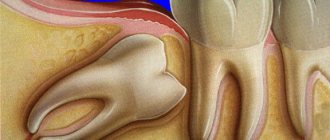Causes of throat swelling
The choice of treatment tactics is closely related to the cause of throat swelling. It can be inflammatory or non-inflammatory in nature. Etiological factors of throat edema:
- pathologies of the immune system;
- respiratory diseases;
- allergic reaction;
- a bite of an insect;
- tumor process;
- injuries.
Sometimes you can discover the cause on your own: people remember an injury or an insect bite. But in most cases, it is worth seeing a doctor to establish the correct diagnosis.
How to recognize swelling of the throat
It can be difficult to understand that the throat is swollen, since the process begins inside and it is difficult to see it on your own. Symptoms of pathology:
- pain and discomfort when swallowing;
- labored breathing;
- stiffness of neck movements;
- irradiation of pain to the ear area;
- dry hacking cough;
- sensation of a foreign body in the larynx;
- change in voice timbre;
- visual increase in neck thickness.
Sometimes swelling of the throat is accompanied by an increase in body temperature. This is typical for an infectious process.
Why does the mucous membrane of the throat swell?
Mechanical damage
Swelling of the throat mucosa due to injury is observed when damaged by hard objects, pieces of food, or fish bones.
Small foreign bodies can get stuck between the ridges, arches, and tonsils in the posterior parts of the oropharynx. The patient complains of severe local pain, soreness, and the sensation of a foreign object. Upon examination, swelling and hyperemia of the affected area are revealed. With deeply located foreign bodies, there are no obvious visual changes. If the object is located in the hypopharynx, suffocation is possible. Thermal burns of the pharyngeal mucosa are usually superficial. They develop when eating too hot food or inhaling hot steam during inhalation. There is a burning sensation that intensifies when swallowing. Chemical injuries to the throat vary in severity and are accompanied by severe pain and the formation of white or gray scabs. In addition, swelling is observed after operations in the area of the oropharynx and hypopharynx.
Infectious diseases
Acute infections are one of the most common causes of swelling of the throat mucosa. The symptom is detected in the following pathologies:
- ARVI and influenza.
Swelling is insignificant, appears in the initial stages of the disease, is combined with moderate hyperemia, weakness, weakness, fever, and muscle pain. - Measles.
The sign is more pronounced in children, complemented by hyperemia and granularity of the pharynx. Occurs simultaneously with fever. After 3-5 days, the condition improves and a rash appears on the body. - Typhus and typhoid fever.
Not only the throat swells, but also the neck and lower part of the face. Peculiar hemorrhages into the mucous membrane are possible. Significant hyperthermia, severe intoxication, and rash are observed. The condition is serious. - Scarlet fever.
The throat is swollen, bright red (“flaming throat”), areas of necrotic, fibrinous or mucopurulent plaque may form. The cervical lymph nodes become enlarged, and a pinpoint rash appears on the body. - Diphtheria.
Against the background of swelling of the pharyngeal mucosa, a typical plaque forms on the tonsils. In severe cases, plaque spreads to the oropharynx and is combined with swelling of the subcutaneous tissue above the enlarged cervical lymph nodes. In the toxic form, swelling of the throat is so severe that it interferes with breathing.
Swelling and other signs of inflammatory damage to the throat mucosa, reminiscent of local symptoms of ARVI, can be detected at the initial stage of hepatitis A, secondary syphilis, and tuberculosis. There are also signs of intoxication, skin rashes, muscle and joint pain, and other symptoms.
Inflammatory ENT pathologies
Swelling of the mucous membrane is accompanied by the most common acute and chronic inflammatory diseases of the pharynx and larynx:
- Tonsillitis.
Swelling and hyperemia of the tonsils, posterior wall of the pharynx, soft and hard palate are determined. Local surface films, loose plaque or purulent foci are formed on the tonsils, reminiscent of a “starry sky” picture. Body temperature is increased. Chronic tonsillitis is manifested by repeated exacerbations, which occur with more sparse symptoms than acute tonsillitis. - Pharyngitis.
In the acute form of the disease, the swelling spreads throughout the entire pharynx; in the chronic form, it covers its upper, middle or lower part. Redness appears. The general condition suffers slightly or remains satisfactory. - Laryngitis.
Swelling of the mucous membrane is localized in the lower parts of the throat and is not visually detectable. There is soreness, scratching, tickling, burning, dry, convulsive cough, and hoarseness. After a few days the cough becomes wet. In chronic laryngitis, the symptoms are smoothed out, the disease proceeds in waves.
Swelling of the throat mucosa
Purulent complications of ENT diseases
Unlike uncomplicated otolaryngological pathologies, which are characterized by diffuse symmetrical damage to the structures of the throat, with purulent complications the symptoms are more often expressed on one side. Upon examination, a local focus is determined; the prevalence of edema depends on the severity of the process. Swelling of the throat is accompanied by the following pathological conditions:
- Peritonsillar abscess.
There is sharp unilateral pain when swallowing; in 10% of cases, bilateral damage is detected. The swelling quickly increases, the pain becomes tearing and radiates to the ear. Due to swelling and accumulation of pus, the tonsil and uvula may deviate to the side. - Retropharyngeal abscess.
Symptoms are determined by location. Along with swelling and sore throat, when the abscess is located in the upper parts of the pharynx, nasal breathing is disrupted. Abscesses of the middle and lower sections are accompanied by hoarseness, deepening of the voice, difficulty breathing, and sometimes suffocation. - Intratonsil abscess
. It is more often observed in adults suffering from chronic tonsillitis and severe somatic diseases. One tonsil becomes sharply painful, enlarges, and takes on a spherical appearance. With cold abscesses due to leukemia, there is no intense pain. - Abscess of the root of the tongue.
Swelling of the pharyngeal mucosa occurs secondarily and is a reaction to the presence of an abscess in nearby tissues. Severe pain, hyperemia in the root zone, and enlarged tongue prevail. - Abscess of the epiglottis.
Severe pain in the lower part of the throat, foreign body sensation, difficulty breathing, and nasal voice predominate. The area of maximum edema is located in the larynx.
In patients with Ludwig's angina, the inflammation is diffuse, beginning in the submandibular space and moving to the floor of the mouth. From there, the swelling spreads to the pharynx, which is accompanied by difficulty swallowing. When the larynx is involved, the voice changes or disappears. Another type of diffuse purulent inflammation is phlegmonous laryngitis. Maximum swelling and pain are observed in the larynx area, loss of speech and acute stenosis of the larynx are possible.
Allergic reactions
Swelling of the throat mucosa is accompanied by many allergic reactions. The symptom appears suddenly, combined with a sore throat, nasal congestion, sneezing, watery eyes, and itchy skin. The most common cause is contact with plant pollen, animals or house dust. This manifestation is especially pronounced in Quincke's edema, which is complemented by swelling of the face and other parts of the body, speech impairment, and wheezing stridor.
Tumors
With benign tumors of the pharynx, the symptom appears in case of trauma to the formations. Pharynx cancer is accompanied by tissue swelling during the disintegration of neoplasia and the development of inflammation of surrounding tissues. Swelling of the mucous membrane of the larynx and pharynx can occur during radiotherapy of the neck organs for oncological lesions of the larynx, pharynx, thyroid gland, and other anatomical formations of this area.
Other reasons
Due to reactive inflammation against the background of reflux of gastric contents, swelling of the throat can be observed with gastroesophageal reflux disease. The symptom is especially often detected in cases of prolonged course of the disease with the development of laryngitis, GERD during pregnancy.
Swelling, soreness, and hyperemia of the throat are typical for some acute poisonings affecting the respiratory system, including berylliosis and toxic pulmonary edema. The symptom appears at the initial stage, then manifestations from the bronchopulmonary system, myalgia, and hyperthermia are added.
Diseases accompanied by swelling of the throat
Swelling in the larynx and neck can be a sign of certain diseases. Pathologies in which the throat swells:
- viral infections - ARVI, influenza;
- bacterial diseases - acute respiratory infections, typhus, measles, tonsillitis, scarlet fever, pharyngitis;
- suppuration in the oropharynx - abscess of the tonsils or epiglottis, retropharyngeal abscess;
- some chronic infections - tuberculosis, syphilis;
- inflammation of the cartilage of the larynx;
- allergy;
- endocrine disorders;
- stagnation of blood in the pharynx, neck or larynx;
- tumor formation of a malignant or benign nature.
Depending on the diagnosis, it becomes clear how to treat a swollen throat. If the cause is not clear, the effectiveness of therapy is in question.
How to treat tonsil diseases?
First, you need to figure out why the tonsil may become inflamed on one side. It is best to consult a doctor. The otolaryngologist will examine the patient, prescribe additional examinations, if necessary, and select treatment.
Quite often, swollen tonsils or an inflamed tonsil on one side are only a complication of another disease. Gargling or washing the tonsils in this case will only have a temporary effect if the cause of the disease is not eliminated.
READ ALSO: Clean & Clear for blackheads: reviews, application, results
Gargling
How to treat a throat if the tonsil hurts on one side - it depends on the accompanying symptoms. It is recommended to start by rinsing with antiseptic agents. If the cause is a bacterial infection of the tonsils, rinsing will help eliminate pathogenic bacteria, and thereby reduce pain and swelling. In cases where pain is associated with injury to the tonsil, rinsing will reduce the risk of secondary infection and speed up the recovery of damaged tissue. For treatment, you can use both pharmaceutical and folk remedies.
- Sea salt. The simplest and most affordable remedy that you can probably find at home, or at least in the nearest supermarket. Salt rinses are recommended for moderate pain, including tonsil injuries. To prepare the solution, dissolve a teaspoon of the product in a glass of water.
- Soda with salt. Another simple remedy, the so-called first aid for a sore throat. To prepare the solution, mix a teaspoon of baking soda and salt in a glass of water. The water should be at a comfortable temperature, about 37 degrees.
- Iodine solution. This remedy has proven itself excellent for stomatitis on the tonsils and tonsillitis. To prepare the solution, mix 5 drops of iodine in a glass of water and gargle thoroughly.
- Chlorophyllipt. Another effective gargle. Used for tonsillitis and pharyngitis. The product is concentrated, diluted with water in proportions of 1 to 5.
- Among folk remedies, you should pay attention to decoctions of chamomile, sage, and calendula. To prepare the solution, pour 1 large spoon of dried raw material into 500 ml of water and cook for 15 minutes. Then cool and use to gargle.
If the tonsil hurts on one side, treatment should be comprehensive. So, you need to gargle at least three times a day. Additionally, you can use various lollipops for tonsillitis and pharyngitis. Unilateral tonsillitis, or inflammation of the tonsil on one side, is treated with Strepsils, Septefril, Hexoral.
To prevent the gland, which is inflamed due to injury, from becoming infected, you can lubricate the damaged area with Lugol's solution.
Compresses
It is strictly not recommended to apply compresses to the throat at very high temperatures.
Compresses help bring down the temperature, but are generally useless for the throat. If your body temperature has risen to 38 degrees, you can put a cool compress on your forehead. At temperatures above 39 degrees, vodka compresses and rubbing are effective.
Traditional medicine suggests placing compresses directly on the neck. However, this method has many contraindications:
- purulent inflammation of the tonsils,
- heat,
- enlargement or inflammation of the cervical lymph nodes.
To reduce pain when swallowing, make compresses from warm crushed potatoes, vinegar solution, and vodka. Such remedies help reduce swelling of the tonsils.
Inhalations
To combat the pain inherent in enlarged tonsils, inhalations can be used. This method has proven itself well in the fight against colds, but is ineffective against tonsillitis or pharyngitis. At the same time, inhalations will prevent a sore throat if one (right or left) tonsil is injured, and also strengthen the immune system and prevent infection.
For inhalation you can use:
- drug Pinosol,
- Chlorophyllipt,
- natural pine essential oil (3 drops per liter of water),
- steam from boiled potatoes.
Inhaling warm steam helps relieve cold symptoms and is effective if sinusitis is the cause of swollen tonsils on one side.
Note! The simplest and most affordable inhaler is the Zvezdochka pencil, containing essential oils of mint, eucalyptus, and camphor. The product can be purchased at any pharmacy at an affordable price.
READ ALSO: Herpes simplex virus. Symptoms and diagnosis.
Inhalations are prohibited at high temperatures.
General therapy
If a person has a swollen tonsil on one side, what to do with this symptom will depend on other signs. In the case of a bacterial infection, your doctor may prescribe broad-spectrum antibiotic tablets. Such drugs cannot be taken independently, without a prescription.
For viral diseases, special immunomodulators are prescribed. Immune medications may be recommended for a speedy recovery. As a folk remedy, you can take tincture of echinacea or propolis.
For severe tonsillitis, the doctor may recommend rinsing the lacunae of the tonsils. This procedure is carried out in case of accumulation of purulent masses in the tonsils and the formation of plugs.
Eagle-Sterling syndrome is treated with novocaine blockades, glucocorticosteroids or surgery if conservative therapy is ineffective. In this case, only a doctor selects a treatment regimen; self-medication can be harmful to health.
Detoxification
Rosehip tea helps a lot
In infectious diseases, intoxication of the body is observed. At high temperatures, a person loses a lot of fluid through sweat, and dehydration occurs. Due to the inflammatory process, weakness and nausea are observed. In such cases, detoxification therapy is necessary. It is carried out either with special mineral-containing solutions (Regidron, Regidron Bio), or by increasing the consumption of pure liquid.
Decoctions of medicinal herbs with a diuretic effect will also come to the rescue. Traditional medicine advises drinking a rosehip decoction, which not only removes toxins, but also strengthens the immune system due to its high vitamin C content. Herbal teas (chamomile, mint, lemon balm) and a decoction of lingonberry leaves are also useful.
Drinking plenty of fluids when sick
If a tonsil that is swollen on one side is the result of a bacterial infection, for example, with tonsillitis, you must follow several recommendations regarding drinking regime and diet. Doctors recommend increasing the amount of fluid you drink to speed up recovery. Recommended to drink:
- clean water at a comfortable temperature,
- herbal teas,
- fruit drinks and compotes,
- warm milk with honey.
Milk reduces discomfort in the throat and eliminates the sore throat characteristic of pharyngitis. It is recommended to drink at least two liters of clean water per day. It is better to drink half a glass every 20-40 minutes.
Having figured out what to do if the tonsil is swollen on one side, you should pay attention to nutrition. It is necessary to remove from the diet any solid food that can irritate the tonsils. It is recommended to increase the consumption of fruits and vegetables, it is better to puree them or drink freshly squeezed juices.
Any food should be at a comfortable temperature; food that is too hot or too cold should be avoided.
Diagnosis of pathology
Only a doctor can make an accurate diagnosis based on a complete examination. If you have a history of allergies and swelling develops rapidly, you should call an emergency medical team. Before doctors arrive, it is worth opening the windows or taking the person out into the fresh air, removing tight clothing, and giving an antihistamine according to age. If the course is not so rapid, you can consult a therapist.
Examination plan:
- taking anamnesis (hypothermia, additional symptoms, contact with patients, etc.);
- inspection;
- general blood analysis;
- swab from the surface of the oropharynx (if necessary);
- Ultrasound of the thyroid gland (as directed by an endocrinologist).
If the therapist could not determine the cause of the edema, the patient is referred to an otolaryngologist or allergist. The next step will be to contact an endocrinologist, infectious disease specialist, and phlebologist. But most often the problem is solved in the therapist’s office.
How to help with throat swelling
If swelling of the throat develops rapidly, only an injection of adrenaline and glucocorticoids can help the patient. Therefore, it is better to call doctors and give the patient an antihistamine. They are available in tablets, drops, and injection solutions. Injections of the drug work the fastest.
If swelling of the throat occurs for other reasons, complex treatment is prescribed. Drugs used as therapy:
- anti-inflammatory drugs - reduce swelling that occurs due to inflammation;
- antibiotics - to treat diseases caused by bacteria;
- diuretics - reduce swelling when severe;
- glucocorticosteroids - act as an emergency measure for severe swelling;
- antihypoxants - prevent the development of tissue oxygen deficiency.
To alleviate the condition, inhalations with antiseptic solutions are also used. They allow you to speed up your recovery.
Read also: Sore throat when swallowing
Dear patients! Remember that only a qualified doctor can make an accurate diagnosis, determine the causes and nature of the disease, and prescribe effective treatment. You can make an appointment with our specialists or call a doctor at home by calling 8-(4822)-33-00-33
Be healthy and happy!
Preventive measures
To keep your tonsils healthy, you need to:
- avoid hypothermia, stress and anything that potentially threatens a decrease in immunity,
- promptly treat any infectious diseases,
- visit the dentist regularly, avoid caries and treat your teeth in a timely manner,
- avoid injury to the tonsils.
If a person is prone to throat diseases, you can consult a doctor about taking prophylactic medications to boost immunity. Quitting smoking will help reduce the risk of developing tonsillitis and pharyngitis.
News MirTesen









